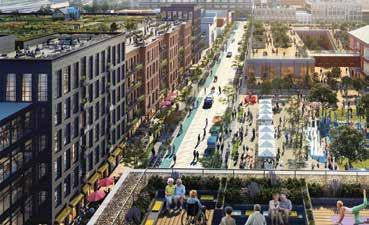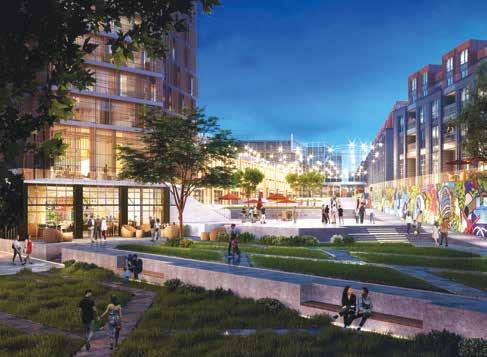
6 minute read
Viewpoint
from SABMag 69 - OUR ANNUAL CANADIAN DIRECTORY of Products and Services for Sustainable High-Performance
by SAB Magazine
BUILDING BACK BETTER
By Steven Paynter
Advertisement
A matter of weeks ago, Justin Trudeau made his Speech from the Throne to open the second session of Canada’s 43rd parliament. In a modern era unlike any other, as the second wave of COVID-19 begins to grip the nation and we eagerly await further economic stimulus, the Prime Minister vowed that Canada would emerge on the other side of the pandemic and “Build Back Better”.
While normally, these speeches have little impact on the design profession, this year was different. Having not had the time to watch it live, I have to admit that the first story I read was about how angry Alberta Premier Jason Kenney was. “Not a single word in the speech discussed the oil industry,” he raged, insisting that it was full of “kooky” objectives! Suddenly, I was interested.
So, what were these “kooky” plans? The main plank of the “build back better recovery” involves a huge injection of cash and loans for sustainable infrastructure projects such as green transit and clean energy, but the one that really piqued my interest, and I’m sure caught the attention of many others in the design professions, was the confirmation of $2 billion from the Infrastructure Bank of Canada to pay for sustainable upgrades to existing buildings.
At first, this sounded like an amazing opportunity to finally get some projects moving, as the funding could easily unlock repositioning deals for those projects that just didn’t quite make economic sense to transform in the wake of COVID-19.
Concepts of the revival and repositioning of Detroit’s downtown core.
After a couple of days of reflecting on it, and after many discussions with our clients, I started to feel disappointed by the idea. It looks like the majority of this money will disappear into mechanical rooms over the next five years, and while we may feel the benefit eventually, it will be, at best, existential for most people.
It turns out $2 billion is spread across the country. It’s just a little over $10 million per city in Canada, with maybe each town seeing upgrades to a few minor projects1. This also translates to roughly $3,500 of projected fee per registered architect meaning it’ll have almost no impact on the industry.
How will this stimulus translate into creating a more sustainable built environment? Maybe the money truly will go into mechanical upgrades, or maybe we’ll see the occasional facade upgrade if we’re lucky. But it doesn’t have to be that way.
What if the money, which I know is enough to tip some projects over the line and into construction, was tied to a bigger, even more sustainable cause? What if we incorporated that funding not only to the performance of the building, but also to its wider socio-economic impact? What if we tied it to creating better neighbourhoods, and design something that could truly be a catalyst for wider change.
It’s a simple idea. If developers want part of the $2 billion pot, then they have to invest double that into other building upgrades that serve the local population. It’s a win/win because there are literally hundreds of landlords and developers out there itching to do this. I’ve spoken to many of them over the course of writing this, and they all agreed that taking the cash sink that is MEP upgrades off their plate would definitely help get things moving.
What would this mean in practice? Well it could mean that a struggling local mall becomes a new beacon for sustainable repositioning with physical changes that improve the quality of the experience there. This is important because we need those obvious changes, we need things to be clear to us, so they can become inspirational and drive change.
1There are approximately 200 cities in Canada with a population over 10,000. On Statistics Canada’s 2016 census list, Toronto ranks 1st and Kenora ranks 200th.

Mechanical room upgrades aren’t going to inspire someone to change their behaviour but adding a new use to a failing piece of real estate can.
Converting empty office space for residential use, refitting suffering retail to be more walkable, or updating lacklustre ground floors to be more engaging and public-facing spaces - all of this will help create all important walkable cities, reduce commutes and get people more engaged with their communities.
We know that these interventions are the ones that will have the biggest impact on mitigating the effects of climate change. If we can encourage people to be inspired to shop locally, walk to work, create more diverse neighbourhoods, get cars off the streets, and design something that is bigger than the narrowly focused propositions of simply transforming mechanical systems, we can make a visible and lasting change that will create a positive impact on our cities and the planet alike.
Nor do I believe this point of view is simply theoretical. In a recent study of GDP for several cities, we noticed a clear correlation between cities like Detroit after the 2008 recession and cities like Calgary now.
After taking a massive economic hit, Detroit is starting to thrive once again. With a revival of the downtown core led by repositioning, it is now attracting major investment from the likes of Bedrock and Related. They are creating a walkable downtown with great transit, including streetcars, and amazing mixeduse districts.
But Detroit had to bottom out, going bankrupt as a city in 2013, before it started to see new investment. Now is the chance for our Canadian cities to invest and avoid that ignominious fate!
As an example, according to Avison Young, Calgary is facing a 26% vacancy rate in its corporate workplace sector with nearly a dozen downtown buildings sitting almost completely empty. For comparison, Colliers shows that Detroit only hit 17.6% in 2013. It’s clear that now is the time to use this Federal investment to jump straight to the recovery phase in our downtown districts. We know what the recovery looks like in terms of communities and real estate, so let’s go straight there, before it gets worse and we see the industrial pollution that became ubiquitous with Detroit.
Of course, this means more work for architects, but more importantly it will mean better cities. This is the real chance to “Build Back Better”. As much as I know one article won’t change government policy, I hope it will change the minds of a few designers, engineers or landlords.
I for one, have already been encouraging clients to apply for this funding to kick start a project, not expecting it to be a project unto itself - and it is working.
The “determined optimism” that Gensler Chairman Joe Brancato has spoken of, is making people think bigger, and hopefully that will allow us to look back to the pandemic from the future, maybe in a net zero 2050, and say that this year really was a turning point.
Maybe we will be able to walk our communities and say, “that building was repositioned in 2021 and it really changed our city”. Because if we don’t focus on this, then we will regret it. All we will have is some fancy new equipment in our mechanical rooms and, yes, we’ll have taken a small step towards tackling climate change, but we won’t take the leap we need.
STEVEN PAYNTER, OAA, ARB, IS A PRINCIPAL WITH GENSLER TORONTO.









